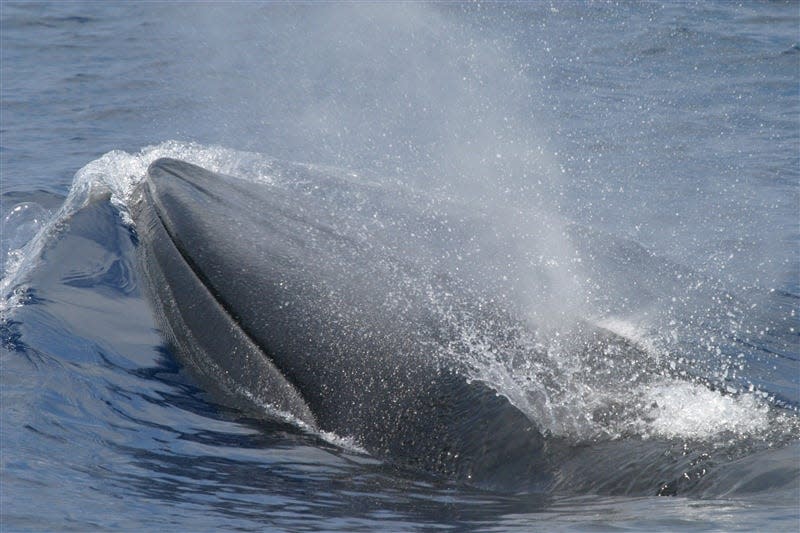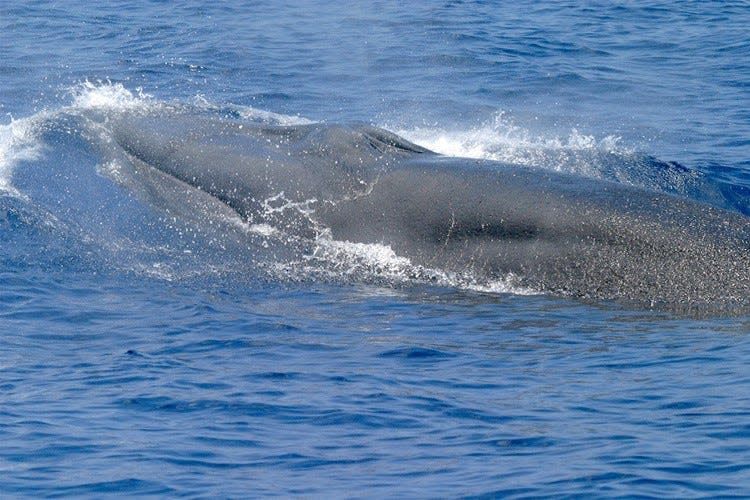The endangerment of this Gulf of Mexico whale by humans deserves our attention
Earlier this week, on June 20, the Orange Beach Alabama website, posted a story with the headline: Gulf of Mexico Rice Whale video 30 miles south of Pensacola.
Any sighting of a Rice's whale is a big deal. Why?
In 2021, the Rice’s whale was recognized as a new species, evolutionarily distinct from other Bryde’s whales around the world. Rice’s whale is the only year-round resident baleen whale in the northern Gulf of Mexico. At an estimated population size of only 51 animals, it is one of the world’s most endangered baleen whales.
Efforts are underway to protect the Rice's whale, including important messaging from experts and others leading the cause to make sure this species isn't killed off by human interaction like vessel strikes and entanglement in fishing nets.
Speed limits proposed: 10-knot offshore speed zone could protect rare whale, but make boat trips very, very slow
Christian Wagley is one of those experts. He is the Florida/Alabama organizer for HealthyGulf, and organization who mission, according to its website, is to collaborate with and serve communities who love the Gulf of Mexico by providing the research, communications, and coalition-building tools needed to reverse the long pattern of over exploitation of the Gulf’s natural resources.
Here are some questions Wagley answered about the Rice's whale:
What do we know about Rice's whale, also called Gulf of Mexico whale?
ANSWER: The Rice’s whale—also called Gulf of Mexico whale--is a member of the baleen whale family, whose members feed by engulfing large amounts of water that is filtered through baleen plates in their mouths in order to capture prey. They can grow to 42’ in length and as much as 30 tons in weight, and have a hooked dorsal fin about two-thirds of the way back along the body.
The National Oceanic and Atmospheric Administration has identified a core area of whale habitat that ranges offshore from Pensacola to Tampa, centered on a dropoff where depths plunge from 300’ to 1200’. However, the whales are also occasionally documented in the western Gulf off Texas and Louisiana. A favored area for the whales is the Desoto Canyon, a submerged valley some 60 miles offshore from Pensacola where depths drop to over 3000’.
Scientists believe that the whales formerly ranged across the Gulf of Mexico along that deepwater dropoff, but that noise from intense industrial activity around oil and gas drilling in the central and western Gulf has pushed the whales to live most of their lives in the quietest and least industrial part of the Gulf off Florida. It is also believed that the shape of the Desoto Canyon could offer some protection from underwater noise, offering an additional reason for the prevalence of whales in that area.
As mammals that must breathe air regularly, Rice’s whales spend most of their time near the surface. But they feed deep underwater, with much of their diet consisting of a small schooling fish called the silver rag driftfish.

How did the Rice's whale become known to humans?
ANSWER: The whales were formally documented when an individual stranded alive in the eastern Florida panhandle in 1965. However, for decades they were believed to be a subspecies of the Bryde’s whale—a species that lives in tropical and temperate regions of oceans worldwide.
In 2019 a Bryde’s whale stranded on the Florida Gulf coast of Everglades National Park and later died. Scientists took this rare opportunity to engage in more detailed study of the deceased specimen.
The morphology of the whale’s skull was compared to that of other Bryde’s whales, and additional genetic analysis was conducted. The results confirmed that these Gulf of Mexico whales are not Bryde’s whales and are actually a fully distinct species. Scientists published their findings in 2021 and named the new species the Rice’s whale after longtime researcher Dale Rice, who first published evidence of the whale in the 1960s.
How do the Rice's whales help to benefit offshore ecosystems?
ANSWER: The Rice’s whale and many species of whale are now recognized as drivers of productivity in the open ocean — areas that are often like biological deserts due to very low nutrient levels. In feeding deep underwater, when the whales return to the surface, they bring nutrients such as nitrogen up from deep water and redistribute them in surface waters when they defecate. These nutrients stimulate the growth of phytoplankton, which form the base of the oceanic food chain. With the whales in such low numbers, the open Gulf is being starved of this natural recycling of nutrients that helps to drive a healthy ocean.
Why is the Rice's whale so rare?
ANSWER: A range of threats has reduced the whale population, with only about 50 Rice’s whales remaining, according to the most recent population estimate by the National Marine Fisheries Service (NMFS). The greatest threats to the whales are vessel strikes, entanglement in fishing gear, energy exploration, ingestion of marine debris, oil spills and noise from industrial activities such as oil drilling and ship traffic. Scientists estimate that around 22% of the whales were killed as a result of the 2010 BP oil disaster.
What is the history of conservation efforts for the Rice's whale?
ANSWER: As with all marine mammals, the Rice’s whale has been afforded Federal protections for decades under the Marine Mammal Protection Act. In 2014, Environmental organizations petitioned the National Marine Fisheries Service (NMFS) to list what was then called the Gulf of Mexico Bryde’s whale as endangered. Following a lawsuit from those organizations, in 2019 NMFS designated the whale as an endangered subspecies under the Endangered Species Act (ESA). The ESA requires the Federal government to act to not only protect the remaining population of whales, but to work to restore their population to a level where they are no longer endangered.
In 2020, conservation organizations sued the Federal government for failing to designate critical habitat for the whales as required by the Endangered Species Act. Such a designation would identify areas of the Gulf that are vital to the whale’s survival. NMFS is expected to designate critical habitat this summer.
In 2021, a coalition of groups filed a petition with NMFS to establish a year-round mandatory 10-knot speed limit and other vessel-related regulations within the core habitat of the Rice’s whale, south of the Florida panhandle. The Federal government has determined that the petition has merit and has opened-up a public comment period on the proposal.

Why are conservationists pushing for speed limits on vessels traveling in areas of primary Rice's whale habitat?
ANSWER: Accidental strikes by vessels are one of the main causes of whale deaths and injuries worldwide, and limits on vessels can be implemented more immediately than other conservation measures. In the past 15 years there are two documented instances of Rice’s whale deaths caused by vessel strikes, though other undocumented deaths and injuries are possible. With such a small population the death of even one whale is catastrophic for the survival of the species.
What's included in the petition for vessel speed restrictions being considered?
ANSWER: The petition recommends that vessels traversing the whale’s core habitat follow a 10-knot speed limit and avoid transit through the area at night, when whales are resting near the surface and unable to be seen. It also recommends that vessels maintain a minimum distance of about 550 yards from observed whales; and to monitor the water around the vessel when traveling through the speed zone. Similar measures are already in place for oil and gas industry vessels operating in the species’ core habitat off Florida and Alabama.
Want to help?
Interested parties can learn more the petition and file comments here: https://www.fisheries.noaa.gov/bulletin/request-comments-noaa-fisheries-requests-public-comments-petition-establish-mandatory?emci=b5daa7c3-2106-ee11-907c-00224832eb73&emdi=0dba7d6a-2406-ee11-907c-00224832eb73&ceid=8879917
This article originally appeared on Fort Myers News-Press: Awareness campaign for Florida's endangered Rice's whale undereway

